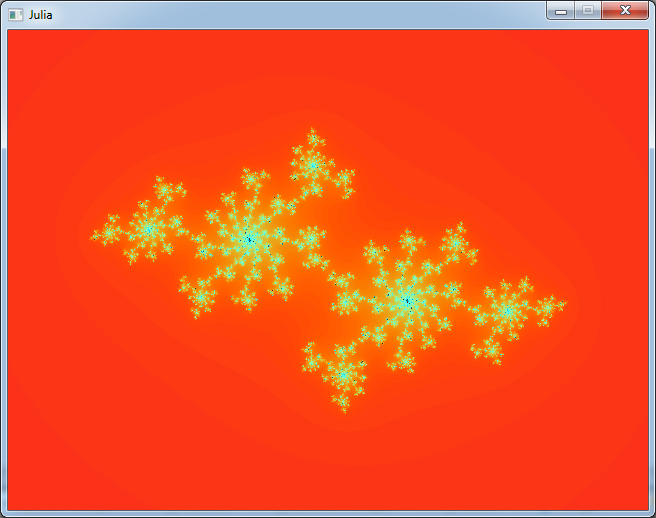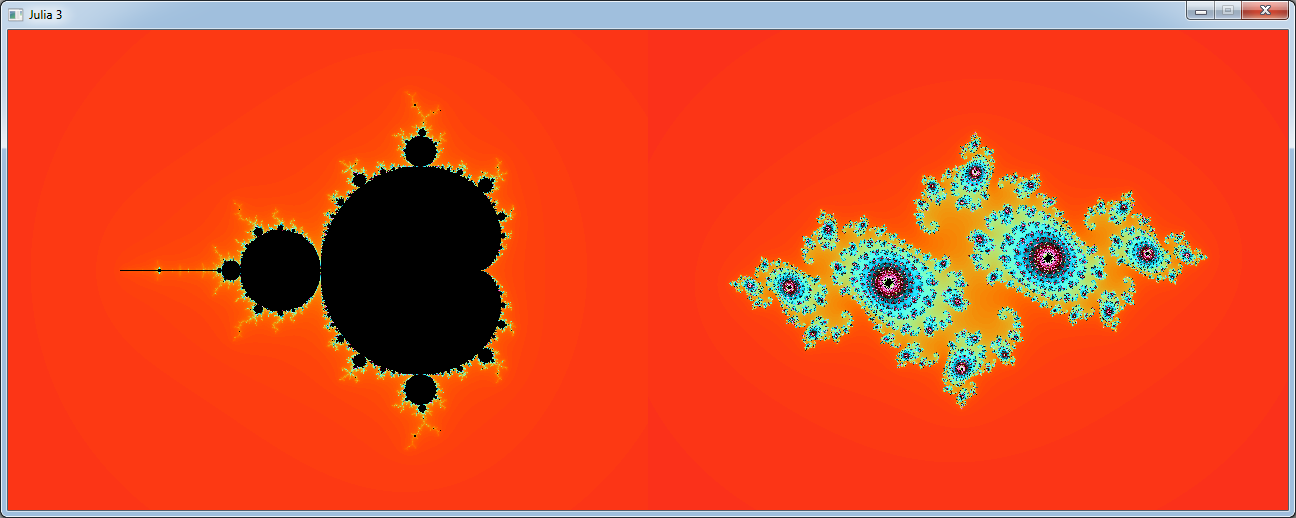The Mandelbrot's cousin
They are so close that generally when mathematicians want to demonstrate a property of the Mandelbrot set, they
first prove it in the Julia set.
Remember the formula we used for the Mandelbrot set.
z0 = 0
zn+1 = zn2 + cpix
In fact, as z1 is always equal to cpix, because 02 = 0, we could also use this formula which would give
us the same set.
z0 = cpix
zn+1 = zn2 + cpix
a constant complex number we chose at the beginning of the drawing.
z0 = cpix
zn+1 = zn2 + c
#include <stdio.h>
#include <stdlib.h>
#include <math.h>
#include "main.h"
#include "Graphics.h"
#include "System.h"
#include "math/Complex.h"
#define SCREEN_WIDTH 640
#define SCREEN_HEIGHT 480
#define MAX_ITERATIONS 256
void drawJulia(int offsetx, int offsety, Color* palette)
{
for (int y = 0; y < SCREEN_HEIGHT; y += 8)
{
for (int x = 0; x < SCREEN_WIDTH; x += 8)
{
// convert the pixel pos to a complex number
Complex z;
z.re = (x + offsetx - SCREEN_WIDTH / 2.0) * 4.0 / SCREEN_WIDTH;
z.im = (y + offsety - SCREEN_HEIGHT / 2.0) * 4.0 / SCREEN_WIDTH;
// julia parameter
Complex c(-0.70176, -0.3842);
int iteration = 0;
while (z.squareMag() <= 16 &&
iteration < MAX_ITERATIONS)
{
// compute the new value
z = z * z + c;
iteration++;
}
// draw the pixel
Color col;
if (iteration == MAX_ITERATIONS)
{
col = Color(0, 0, 0);
}
else
{
col = palette[iteration];
}
gfx.setPixel(x + offsetx, y + offsety, col);
}
}
}
int main(int argc, char* argv[])
{
// init the window
gfx.init("Julia", SCREEN_WIDTH, SCREEN_HEIGHT);
gfx.init2D();
gfx.clearScreen(Color(0, 0, 0, SDL_ALPHA_OPAQUE));
static Uint8 pattern[64] =
{
0, 32, 8, 40, 2, 34, 10, 42,
48, 16, 56, 24, 50, 18, 58, 26,
12, 44, 4, 36, 14, 46, 6, 38,
60, 28, 52, 20, 62, 30, 54, 22,
3, 35, 11, 43, 1, 33, 9, 41,
51, 19, 59, 27, 49, 17, 57, 25,
15, 47, 7, 39, 13, 45, 5, 37,
63, 31, 55, 23, 61, 29, 53, 21
};
static Color palette[256];
// set up the palette
for (int i = 0; i < 256; ++i)
{
float angle = 2.0 * M_PI * (float)i / 256.0;
float offset = 2.0 * M_PI / 3.0;
angle += 40.0 * M_PI / 128.0;
angle *= 1.3;
palette[i].r = 128 + 128 * sin(angle);
palette[i].g = 128 + 128 * sin(angle * 1.1 - offset);
palette[i].b = 128 + 128 * sin(angle * 1.5 + offset);
}
for (int i = 0; i < 64; i++)
{
int j = 0;
while (pattern[j] != i)
j++;
drawJulia(j % 8, j / 8, palette);
// display and process the events
gfx.render();
sys.wait(50);
sys.processEvents();
if (sys.isQuitRequested() == true)
exit(EXIT_SUCCESS);
}
// wait until we quit
while (sys.isQuitRequested() == false)
{
sys.processEvents();
sys.wait(50);
}
gfx.quit();
return EXIT_SUCCESS;
}
Download source code
Download executable for Windows


 Science & Vie Micro n°27
Science & Vie Micro n°27 Video: Julia Set in processing
Video: Julia Set in processing